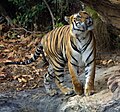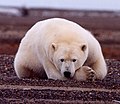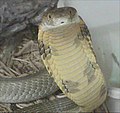Apex predator
Apex predators (also alpha predators or superpredators) are predators that are not preyed upon in the wild. These species are often at the end of long food chains, where they have a crucial role in maintaining and determining the health of ecosystems. Even those not dangerous to humans (for example, owls) are formidable predators in their respective niches.
Apex predators often have a special place in human culture and they have come to represent aspects of nature that humans find important and often appear in heraldry. A hawk appears on the national symbol of Egypt. The eagle is the animal symbol of several European countries (such as Austria, Germany, Poland, Serbia and Russia), Mexico, and the United States of America; a lion has so served ancient Assyria and modern Great Britain, Bulgaria, Flanders, Finland, Czech Republic and the Netherlands. Tigers represent Korea, Bangladesh, India and also represented former Nazi Germany and the former USSR. Bears symbolize Russia. Some, such as tigers and lions, are hunted by humans for trophies or used in Chinese medicine.
Humans are themselves superpredators, and under some conditions, so are dogs, particularly if large, in packs, attack-trained, or fight-trained. Damage that dogs do to wildlife and livestock qualifies at least the large or pack-organized gangs as superpredators. The mutualistic human-dog collaboration in herding and hunting makes them rivals of the big cats in effectiveness.
Due to their placement atop the food chain, many (but not all) apex predators are also keystone predators. For instance, the Great White Shark is an apex predator, but it is not a keystone predator: it has not been demonstrated to regulate prey species within the ecosystem. The gray wolf, on the other hand, is both an apex predator and a keystone predator, as it keeps populations of deer (or caribou), hares, and beavers in control.
-
The solitary cats are the apex predators wherever they are the largest; the tiger is the largest of them all.
-
Orcas can kill anything that gets into the water with them.
-
Polar bears are the largest bear species in the world.
-
Large snakes, such as the Green Anaconda and Reticulated Python are deadly superpredators.
-
Lions are superpredators that operate in groups called prides.
-
The Great White Shark is another example of a superpredator.
-
Wolves are superpredators because they are efficient and cooperative hunters.
-
Eagles and other birds of prey are formidable superpredators. The eagle pictured is a Golden Eagle.
-
Unlike other seals that go after smaller prey, the leopard seal kills penguins and other seals and has the ecological role in the Antarctic that the polar bear has in the Arctic.
-
The electric eel shocks its prey and any intruder into its territory with up to 600 volts of electrical current.
-
Wolverines, despite their small size, are known to kill animals as large as moose and to steal food from even bears and wolves.
-
The king cobra, which largely eats other snakes, can deliver enough venom with which to kill an elephant within three hours.
External links
- "Super-predator is regular visitor," The Guardian, June 2, 2005
- "Man-eating lions not aberrant, experts say," National Geographic News, January 4, 2004
- "Making the Case for Man-Eaters," National Geographic Today, October 9, 2003
- "Native Carnivores in the Southern Rockies








